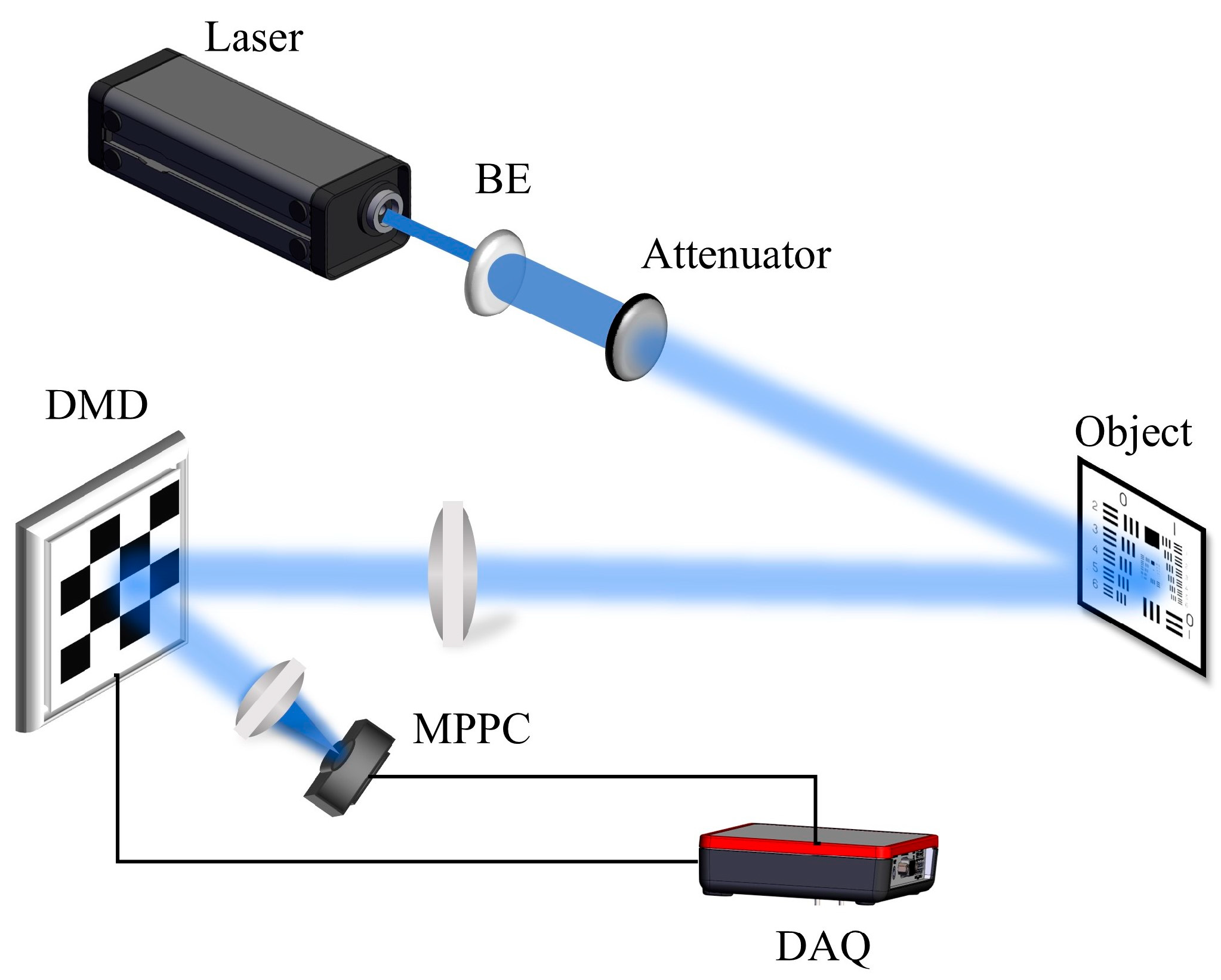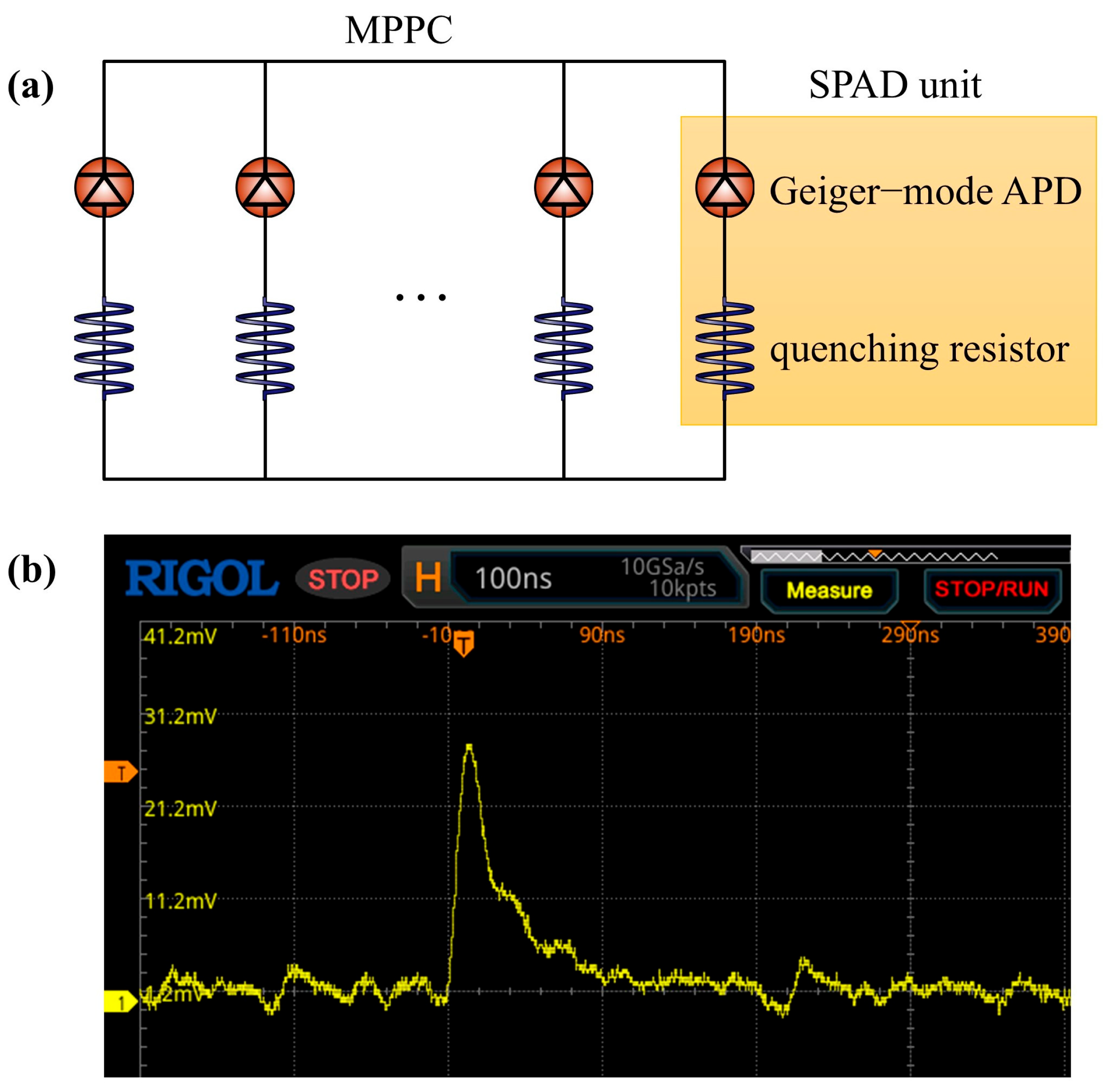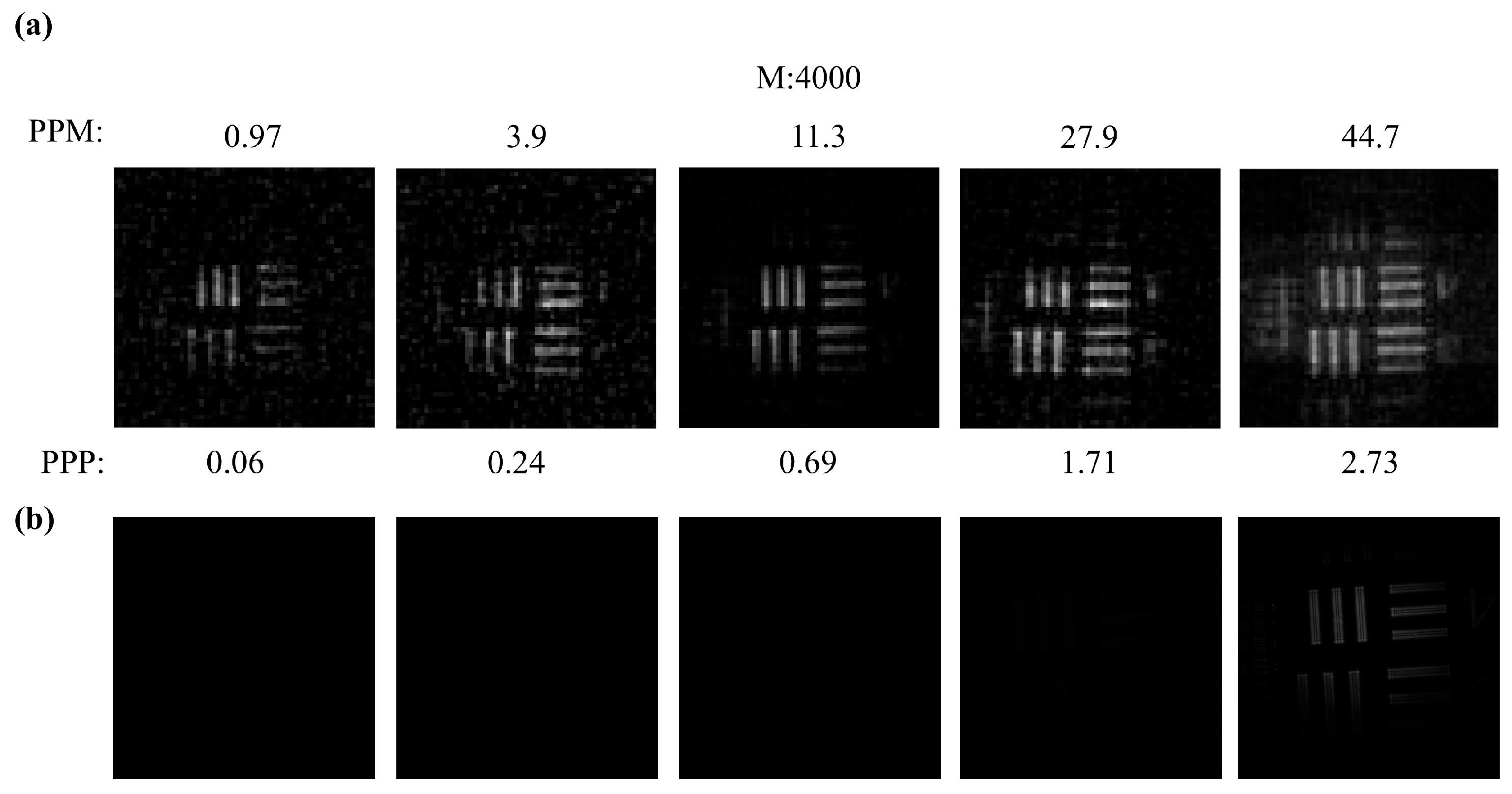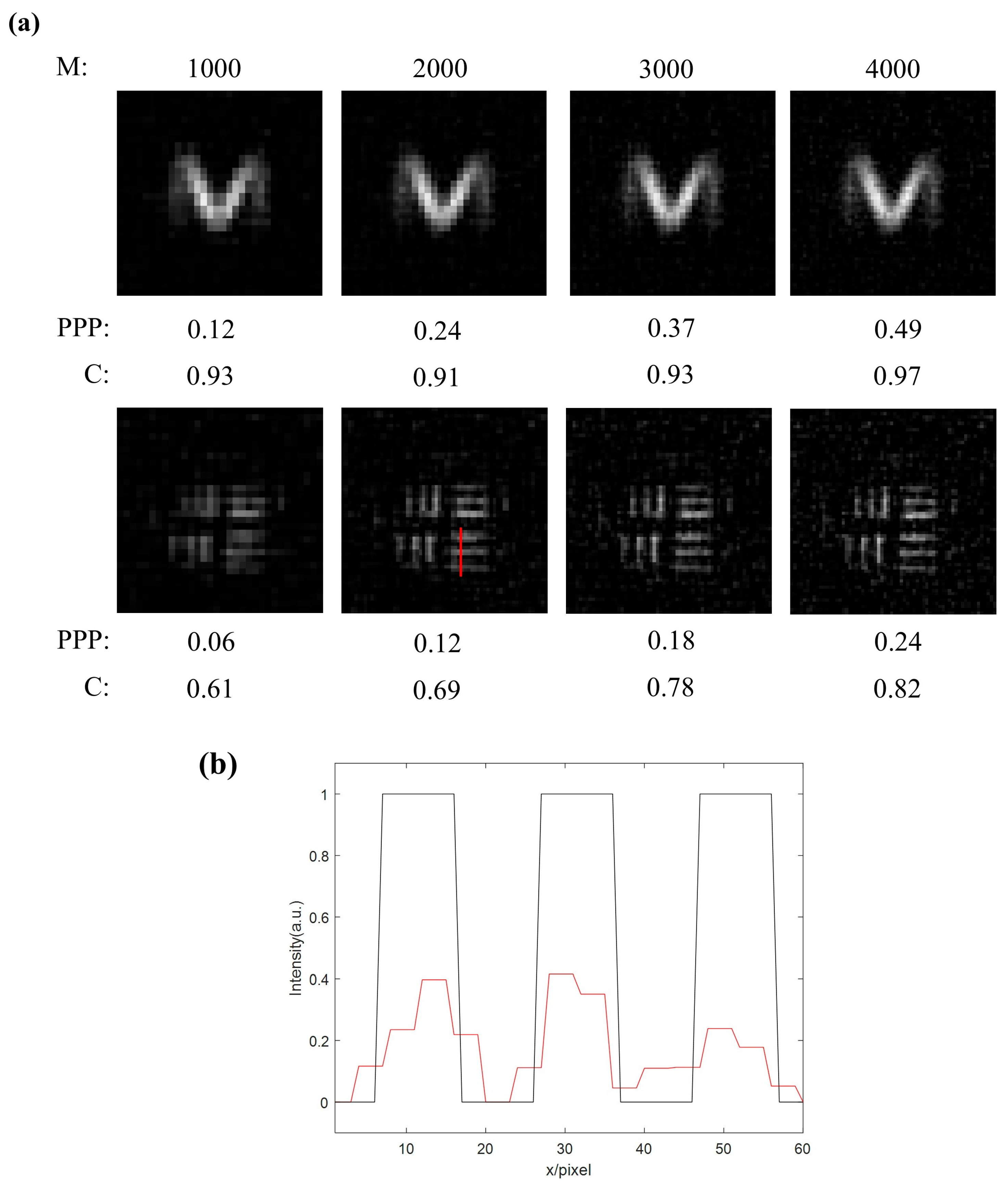Single-Photon Computational Imaging System Based on Multi-Pixel Photon Counter
Abstract
1. Introduction
2. Methods
2.1. Principle of the Imaging System
2.2. Principle of MPPC
2.3. Hadamard SPI Method
3. Results
4. Discussion
5. Conclusions
Author Contributions
Funding
Institutional Review Board Statement
Informed Consent Statement
Data Availability Statement
Conflicts of Interest
References
- Hadfield, R.H.; Leach, J.; Fleming, F.; Paul, D.J.; Tan, C.H.; Ng, J.S.; Henderson, R.K.; Buller, G.S. Single-photon detection for long-range imaging and sensing. Optica 2023, 10, 1124–1141. [Google Scholar] [CrossRef]
- Kirmani, A.; Venkatraman, D.; Shin, D.; Colaço, A.; Wong, F.N.; Shapiro, J.H.; Goyal, V.K. First-photon imaging. Science 2014, 343, 58–61. [Google Scholar] [CrossRef] [PubMed]
- Shin, D.; Xu, F.; Venkatraman, D.; Lussana, R.; Villa, F.; Zappa, F.; Goyal, V.K.; Wong, F.N.; Shapiro, J.H. Photon-efficient imaging with a single-photon camera. Nat. Commun. 2016, 7, 12046. [Google Scholar] [CrossRef]
- Bian, L.; Song, H.; Peng, L.; Chang, X.; Yang, X.; Horstmeyer, R.; Ye, L.; Zhu, C.; Qin, T.; Zheng, D.; et al. High-resolution single-photon imaging with physics-informed deep learning. Nat. Commun. 2023, 14, 5902. [Google Scholar] [CrossRef]
- Shin, D.; Xu, F.; Wong, F.N.; Shapiro, J.H.; Goyal, V.K. Computational multi-depth single-photon imaging. Opt. Express 2016, 24, 1873–1888. [Google Scholar] [CrossRef]
- Li, Z.-P.; Ye, J.-T.; Huang, X.; Jiang, P.-Y.; Cao, Y.; Hong, Y.; Yu, C.; Zhang, J.; Zhang, Q.; Peng, C.-Z.; et al. Single-photon imaging over 200 km. Optica 2021, 8, 344–349. [Google Scholar] [CrossRef]
- Li, Z.-P.; Huang, X.; Jiang, P.-Y.; Hong, Y.; Yu, C.; Cao, Y.; Zhang, J.; Xu, F.; Pan, J.-W. Super-resolution single-photon imaging at 8.2 kilometers. Opt. Express 2020, 28, 4076–4087. [Google Scholar] [CrossRef]
- Hong, Y.; Liu, S.; Li, Z.-P.; Huang, X.; Jiang, P.; Xu, Y.; Wu, C.; Zhou, H.; Zhang, Y.-C.; Ren, H.-L.; et al. Airborne single-photon LiDAR towards a small-sized and low-power payload. Optica 2024, 11, 612–618. [Google Scholar] [CrossRef]
- Liao, S.; Cheng, W.; Liu, W.; Yang, Z.; Ding, Y. Distributed Optimization for Utility-Energy Tradeoff in Wireless Sensor Networks. In Proceedings of the 2007 IEEE International Conference on Communications, Glasgow, UK, 24–28 June 2007; IEEE: New York, NY, USA, 2007; pp. 3190–3194. [Google Scholar]
- Zhang, Y.; He, Z.; Tong, X.; Garrett, D.C.; Cao, R.; Wang, L.V. Quantum imaging of biological organisms through spatial and polarization entanglement. Sci. Adv. 2024, 10, eadk1495. [Google Scholar] [CrossRef]
- Mai, H.; Jarman, A.; Erdogan, A.T.; Treacy, C.; Finlayson, N.; Henderson, R.K.; Poland, S.P. Development of a high-speed line-scanning fluorescence lifetime imaging microscope for biological imaging. Opt. Lett. 2023, 48, 2042–2045. [Google Scholar] [CrossRef]
- Zhan, X.; Gan, C.; Ding, Y.; Hu, Y.; Xu, B.; Deng, D.; Liao, S.; Xi, J. Speckle noise suppression based on Empirical mode decomposition and improved anisotropic diffusion equation. Photonics 2022, 9, 611. [Google Scholar] [CrossRef]
- Maccarone, A.; Drummond, K.; McCarthy, A.; Steinlehner, U.K.; Tachella, J.; Garcia, D.A.; Pawlikowska, A.; Lamb, R.A.; Henderson, R.K.; McLaughlin, S.; et al. Submerged single-photon LiDAR imaging sensor used for real-time 3D scene reconstruction in scattering underwater environments. Opt. Express 2023, 31, 16690–16708. [Google Scholar] [CrossRef] [PubMed]
- Maccarone, A.; Della Rocca, F.M.; McCarthy, A.; Henderson, R.; Buller, G.S. Three-dimensional imaging of stationary and moving targets in turbid underwater environments using a single-photon detector array. Opt. Express 2019, 27, 28437–28456. [Google Scholar] [CrossRef] [PubMed]
- Li, Z.-M.; Zhou, H.; Li, Z.-Y.; Yan, Z.-Q.; Hu, C.-Q.; Gao, J.; Wu, S.-B.; Yin, S.-Y.; Jin, X.-M. Thresholded single-photon underwater imaging and detection. Opt. Express 2021, 29, 28124–28133. [Google Scholar] [CrossRef]
- Shi, H.; Qi, H.; Shen, G.; Li, Z.; Wu, G. High-resolution underwater single-photon imaging with Bessel beam illumination. IEEE J. Sel. Top. Quantum Electron. 2022, 28, 1–6. [Google Scholar] [CrossRef]
- Shangguan, M.; Yang, Z.; Lin, Z.; Lee, Z.; Xia, H.; Weng, Z. Compact Long-Range Single-Photon Underwater Lidar with High Spatial–Temporal Resolution. IEEE Geosci. Remote Sens. Lett. 2023, 20, 1–5. [Google Scholar] [CrossRef]
- Yang, M.; Xu, F.; Ren, J.-G.; Yin, J.; Li, Y.; Cao, Y.; Shen, Q.; Yong, H.-L.; Zhang, L.; Liao, S.-K.; et al. Spaceborne, low-noise, single-photon detection for satellite-based quantum communications. Opt. Express 2019, 27, 36114–36128. [Google Scholar] [CrossRef]
- Xue, L.; Li, Z.; Zhang, L.; Zhai, D.; Li, Y.; Zhang, S.; Li, M.; Kang, L.; Chen, J.; Wu, P.; et al. Satellite laser ranging using superconducting nanowire single-photon detectors at 1064 nm wavelength. Opt. Lett. 2016, 41, 3848–3851. [Google Scholar] [CrossRef]
- Vallone, G.; Dequal, D.; Tomasin, M.; Vedovato, F.; Schiavon, M.; Luceri, V.; Bianco, G.; Villoresi, P. Interference at the single photon level along satellite-ground channels. Phys. Rev. Lett. 2016, 116, 253601. [Google Scholar] [CrossRef]
- Hadfield, R.H. Single-photon detectors for optical quantum information applications. Nat. Photonics 2009, 3, 696–705. [Google Scholar] [CrossRef]
- Defienne, H.; Zhao, J.; Charbon, E.; Faccio, D. Full-field quantum imaging with a single-photon avalanche diode camera. Phys. Rev. A 2021, 103, 042608. [Google Scholar] [CrossRef]
- Lemos, G.B.; Borish, V.; Cole, G.D.; Ramelow, S.; Lapkiewicz, R.; Zeilinger, A. Quantum imaging with undetected photons. Nature 2014, 512, 409–412. [Google Scholar] [CrossRef] [PubMed]
- Maring, N.; Fyrillas, A.; Pont, M.; Ivanov, E.; Stepanov, P.; Margaria, N.; Hease, W.; Pishchagin, A.; Lemaître, A.; Sagnes, I.; et al. A versatile single-photon-based quantum computing platform. Nat. Photonics 2024, 18, 603–609. [Google Scholar] [CrossRef]
- Abramović, D.; Demoli, N.; Stipčević, M.; Skenderović, H. Quantum holography with single-photon states. Phys. Rev. A 2023, 108, 013709. [Google Scholar] [CrossRef]
- Wang, Y.; Huang, K.; Fang, J.; Yan, M.; Wu, E.; Zeng, H. Mid-infrared single-pixel imaging at the single-photon level. Nat. Commun. 2023, 14, 1073. [Google Scholar] [CrossRef]
- Morris, P.A.; Aspden, R.S.; Bell, J.E.; Boyd, R.W.; Padgett, M.J. Imaging with a small number of photons. Nat. Commun. 2015, 6, 5913. [Google Scholar] [CrossRef] [PubMed]
- Yang, Y.; Shi, J.; Cao, F.; Peng, J.; Zeng, G. Computational imaging based on time-correlated single-photon-counting technique at low light level. Appl. Opt. 2015, 54, 9277–9283. [Google Scholar] [CrossRef]
- Liu, X.; Shi, J.; Wu, X.; Zeng, G. Fast first-photon ghost imaging. Sci. Rep. 2018, 8, 5012. [Google Scholar] [CrossRef]
- Yang, J.-Z.; Li, M.-F.; Chen, X.-X.; Yu, W.-K.; Zhang, A.-N. Single-photon quantum imaging via single-photon illumination. Appl. Phys. Lett. 2020, 117, 21. [Google Scholar] [CrossRef]
- Zhao, Y.-N.; Hou, H.-Y.; Han, J.-C.; Liu, H.-C.; Zhang, S.-H.; Cao, D.-Z.; Liang, B.-L. Full-color photon-counting single-pixel imaging. Opt. Lett. 2021, 46, 4900–4903. [Google Scholar] [CrossRef]
- Sun, R.; Kuang, J.; Ding, Y.; Long, J.; Hu, Y.; Liao, S.; Xi, J. High-Efficiency Differential Single-Pixel Imaging Based on Discrete Cosine Transform. IEEE Photonics Technol. Lett. 2023, 35, 955–958. [Google Scholar] [CrossRef]
- Sun, M.-J.; Chen, W.; Liu, T.-F.; Li, L.-J. Image Retrieval in Spatial and Temporal Domains with a Quadrant Detector. IEEE Photonics J. 2017, 9, 1–6. [Google Scholar] [CrossRef]
- Liu, C.; Chen, J.; Liu, J.; Han, X. High Frame-Rate Computational Ghost Imaging System Using an Optical Fiber Phased Array and a Low-Pixel APD Array. Opt. Express 2018, 26, 10048–10064. [Google Scholar] [CrossRef]
- Natarajan, C.M.; Tanner, M.G.; Hadfield, R.H. Superconducting Nanowire Single-Photon Detectors: Physics and Applications. Supercond. Sci. Technol. 2012, 25, 063001. [Google Scholar] [CrossRef]
- Xiao, Y.; Cao, X.; Liu, X.; Jia, L.; Huang, J.; Li, H.; Wu, A.; Wang, Z.; You, L. Ultralow-Filling-Factor Superconducting Nanowire Single-Photon Detector Utilizing a 2D Photonic Crystal. Photonics Res. 2023, 11, 2128–2135. [Google Scholar] [CrossRef]
- De Lucia, M.; Dal Bo, P.; Di Giorgi, E.; Lari, T.; Puglia, C.; Paolucci, F. Transition Edge Sensors: Physics and Applications. Instruments 2024, 8, 47. [Google Scholar] [CrossRef]
- Sato, K.; Yamamoto, K.; Yamamura, K.; Kamakura, S.; Ohsuka, S. Application Oriented Development of Multi-Pixel Photon Counter (MPPC). In Proceedings of the IEEE Nuclear Science Symposuim & Medical Imaging Conference, Knoxville, TN, USA, 30 October–6 November 2010; pp. 243–245. [Google Scholar]
- Hamamatsu Photonics, K.K. Technical Note MPPC. 2024. Available online: https://www.hamamatsu.com.cn/content/dam/hamamatsu-photonics/sites/documents/99_SALES_LIBRARY/ssd/mppc_kapd9008e.pdf (accessed on 12 March 2025).
- Sun, R.; Long, J.; Ding, Y.; Kuang, J.; Xi, J. Hadamard Single-Pixel Imaging Based on Positive Patterns. Photonics 2023, 10, 395. [Google Scholar] [CrossRef]
- Zhang, Z.; Wang, X.; Zheng, G.; Zhong, J. Hadamard single-pixel imaging versus Fourier single-pixel imaging. Opt. Express 2017, 25, 19619–19639. [Google Scholar] [CrossRef]
- Sun, R.; Ding, Y.; Cheng, J.; Pan, J.; Zhuo, J.; Yuan, X. Robust Two-Step Fourier Single-Pixel Imaging. Chin. Opt. Lett. 2025, 23, 031102. [Google Scholar] [CrossRef]





Disclaimer/Publisher’s Note: The statements, opinions and data contained in all publications are solely those of the individual author(s) and contributor(s) and not of MDPI and/or the editor(s). MDPI and/or the editor(s) disclaim responsibility for any injury to people or property resulting from any ideas, methods, instructions or products referred to in the content. |
© 2025 by the authors. Licensee MDPI, Basel, Switzerland. This article is an open access article distributed under the terms and conditions of the Creative Commons Attribution (CC BY) license (https://creativecommons.org/licenses/by/4.0/).
Share and Cite
Sun, R.; Kuang, J.; Ding, Y.; Cheng, J.; Zhang, J.; Wang, Y.; Buczynski, R.; Liu, W. Single-Photon Computational Imaging System Based on Multi-Pixel Photon Counter. Photonics 2025, 12, 542. https://doi.org/10.3390/photonics12060542
Sun R, Kuang J, Ding Y, Cheng J, Zhang J, Wang Y, Buczynski R, Liu W. Single-Photon Computational Imaging System Based on Multi-Pixel Photon Counter. Photonics. 2025; 12(6):542. https://doi.org/10.3390/photonics12060542
Chicago/Turabian StyleSun, Rui, Jiaye Kuang, Yi Ding, Jingjing Cheng, Jibin Zhang, Yadong Wang, Ryszard Buczynski, and Wenzhong Liu. 2025. "Single-Photon Computational Imaging System Based on Multi-Pixel Photon Counter" Photonics 12, no. 6: 542. https://doi.org/10.3390/photonics12060542
APA StyleSun, R., Kuang, J., Ding, Y., Cheng, J., Zhang, J., Wang, Y., Buczynski, R., & Liu, W. (2025). Single-Photon Computational Imaging System Based on Multi-Pixel Photon Counter. Photonics, 12(6), 542. https://doi.org/10.3390/photonics12060542





